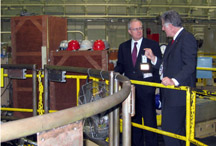Presidential Science Advisor John Marburger receives Sandia science overview

Responding to a wide spectrum of national issues is a major strength of Sandia, said John Marburger, science advisor to President Bush and director of Office of Science and Technology Policy, during a recent visit to Sandia.
“Sandia is a broad-spectrum lab,” Marburger said after receiving a comprehensive tour and overview of Sandia. “Sandia’s responsiveness to the nation is outstanding.”
He said he was impressed with the quality and enthusiasm of the employees at Sandia and commended the mission and goals of the Laboratories.
Marburger said Sandia’s work is a perfect fit for the three areas set forth by the current administration. The areas include winning the war on terrorism, protecting the homeland, and contributing to economic stability. He said he realizes that science plays a major role in contributing to these areas.
Marburger toured the Microelectronics Development Laboratory, Integrated Materials Research Lab, and the Z machine. Hosted by VP for Science & Technology and Partnerships 1000 Pace VanDevender, Marburger was briefed on the progress of the Microsystems and Engineering Sciences Applications (MESA) project, the Biotechnology Program, and Global Nuclear Futures.
Marburger said making things smaller and faster is key in meeting the challenges of the new century
“The smaller the scale, the more robust technology can be,” he said. “The use of information and image technology all lead to useful products.”
He said Sandia’s MESA project will play an important role in the area of nanotechnology.
Nanoscale structures, he said, will lead to opportunities for new devices as small as molecules, and machines as small as human cells.
Work in the area of biotechnology helps pave the way toward better diagnostics, therapies, treatments, and possible cures that affect the lives of all Americans, he said.
Moving new technology from the lab to products is a difficult task, he said, adding that certain technologies can transfer more rapidly than others.
“The key to successful technology transfer is to encourage flexibility within the process,” he said. “We need to make sure the transformation is safe and feasible, but we need to do this quickly.”
Prior to his appointment to the Executive Office of the President, he served as director of Brookhaven National Laboratory from 1998, and as the third president of the State University of New York at Stony Brook from 1980-1994.
“Sandia is well-run and has a strong vision and a good vision,” he said. “I am leaving with a very favorable impression of the Labs.”